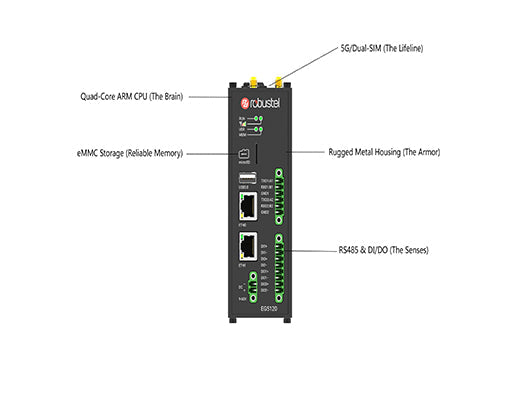
What is an IoT Edge Gateway? The Essential Hardware for Edge Computing
|
|
Time to read 5 min
|
|
Time to read 5 min
So, what is an IoT Edge Gateway? In simple terms, it's a rugged, on-site industrial computer purpose-built to be the intelligent bridge between your physical Operational Technology (OT) world of machines and sensors, and your digital Information Technology (IT) world of servers and the cloud. Unlike a simple router, it has a powerful processor, reliable storage, and rich industrial interfaces, making it the essential hardware platform that brings the promise of local data processing—edge computing—to life.
An IoT Edge Gateway is fundamentally a ruggedized, industrial-grade computer, not just a simple router or data forwarder. It's designed to process data locally.
Key hardware features to demand are a powerful multi-core ARM CPU, reliable soldered-on eMMC storage (not SD cards) , and a rich set of industrial I/O ports (like RS485 and DI/DO).
It combines the functions of an industrial PC, a cellular router, and a protocol converter into a single, compact, and reliable device.
This hardware is the physical foundation upon which all successful edge computing applications are built.
You've done the research, you understand the benefits, and you've made the strategic decision to leverage edge computing for your next IIoT project. That's a great first step. But now comes the critical question: what hardware do you actually run it on?
You could try to cobble something together with a single-board computer like a Raspberry Pi, but as we've discussed, that path is filled with hidden costs and reliability risks. You could use an industrial router, but its main job is connectivity, not computation.
Let's be clear: to do edge computing professionally, you need a purpose-built piece of hardware. You need an IoT Edge Gateway. This guide will take you on a hardware deep dive, breaking down exactly what this device is and what critical components you should look for.

Before we look inside, let's establish the primary job of an IoT Edge Gateway. Its mission is to be the intelligent bridge that enables OT/IT convergence. It lives on-site in the harsh OT world—the factory floor, the substation, the roadside cabinet—and performs several critical tasks:
To accomplish this mission, it needs a very specific set of hardware features.
A basic router might have a simple CPU designed for packet forwarding. An edge gateway needs a true computing brain. The real 'aha!' moment for many developers is realizing they have the power of a real computer at their disposal.
In the industrial world, reliability is everything, and this is especially true for storage.
An edge gateway must be able to talk to the diverse range of equipment found in the field.
RS232/RS485 serial ports for connecting to older PLCs and meters, and isolated Digital I/O (DI/DO) for monitoring simple on/off states and triggering relays.
Your gateway will be living in a tough neighborhood. It needs to be built for it.
DIN-rail mounting for clean installation in control cabinets.
A gateway isn't much use if it can't communicate.
Dual SIM failover for carrier redundancy—as well as Wi-Fi and Ethernet WAN options.

So, what is an IoT Edge Gateway? It's a specialized class of industrial computer, meticulously engineered to provide the processing power, versatile connectivity, and rugged reliability required to run intelligent applications at the network edge.
While the software and algorithms often get the spotlight, they are useless without a solid hardware foundation. By choosing a gateway with the right combination of a powerful CPU, reliable eMMC storage, rich industrial I/O, and a truly rugged design, you are making the first and most critical step toward building a successful, scalable, and resilient edge computing solution.
Learn more in our main guide:

You can, but a dedicated IoT Edge Gateway offers key advantages. Gateways are typically smaller, more power-efficient, and, most importantly, are designed with integrated connectivity (like built-in 4G/5G modems) and remote management capabilities (like RCMS) at their core. An IPC often requires you to add these components separately, increasing complexity and cost.
It means the device has been specifically designed and tested to survive in harsh operational environments. This isn't just a marketing term; it refers to specific, verifiable features like a wide operating temperature range (-40 to +70°C), resistance to shock and vibration, a fanless design to protect from dust, and high electromagnetic compatibility (EMC) to resist electrical noise.
No, and this is a critical distinction. The term is often misused. A basic "IoT Gateway" might only perform simple data forwarding or protocol conversion. A true
"IoT Edge Gateway" has a powerful processor and an open operating system (like Linux) that allows you to run your own custom applications and process data locally. Always check the CPU, RAM, and OS specifications.